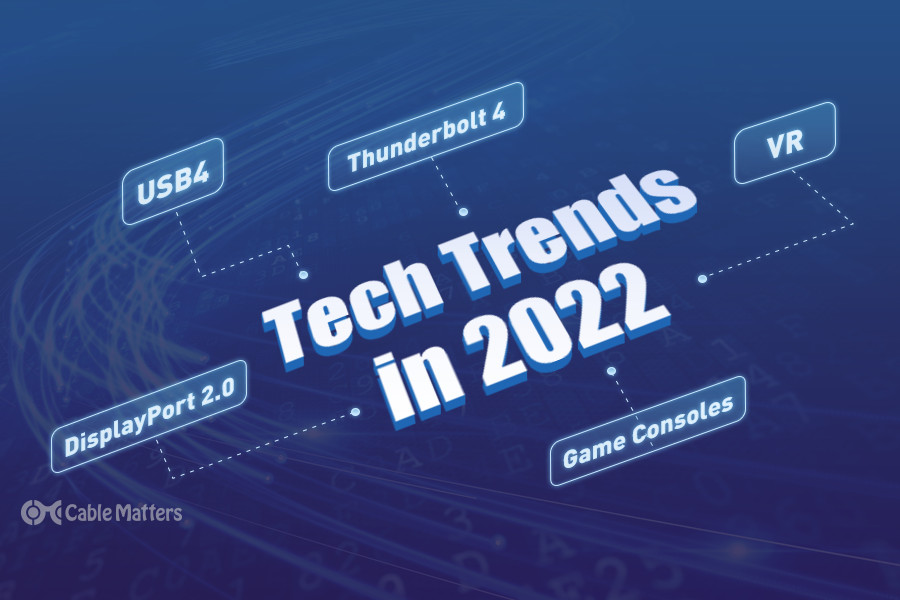
As exciting as 2021 has been, it soon draws to a close and all eyes are on what 2022 might bring in the world of technology. There will be big releases from all the major chip and system manufacturers, and many of them will have support for some exciting new technologies that will improve refresh rates, resolution support, and data transfer speeds like never before.
Here are some of the top tech trends to look for in 2022.
DisplayPort 2.0 in 2022
DisplayPort has long been the connector of choice for high-end gaming PCs, typically offering greater bandwidth support over the HDMI alternatives. But that all changed with the release of HDMI 2.1, ushering in a couple of years of bandwidth dominance, backed up by support on all new manner of TVs and the new-generation games consoles from both Microsoft and Sony. But in 2022, DisplayPort will make its big comeback and in dramatic fashion.
DisplayPort 2.0 will treble the bandwidth over existing DisplayPort 1.4 connections, to a maximum 77.37Gbps; that’s almost twice that of HDMI 2.1. It opens up support for 4K resolution at 240Hz without any display stream compression (DSC), and makes 8K at up to 85Hz a reality. If DSC is enabled, however, it could even handle a 16K display at 60Hz with HDR enabled.
Although it will be years before these kind of resolutions could be reached in mainstream gaming, we may see new generation graphics cards launching in the latter months of 2022 that offer the first support for this new standard.
Thunderbolt 4 and USB 4 in 2022
We’ve already started to see Thunderbolt 4 and USB 4 appear in some modern laptops (and Thunderbolt 4 cables are available now) but they’ll become far more mainstream connectors in 2022. That’s a good thing too, as both offer exciting advancements in external display support and data transfer rates. While both ports might look the same on the surface, though, there are some stark differences between them – and if you ever have the choice, Thunderbolt 4 will be the way to go.
Thunderbolt 4 is what Thunderbolt 3 was supposed to be – it just mandates all of the maximum performance that Thunderbolt 3 was capable of. So Thunderbolt 4 devices must have a minimum data transfer rate of 40 Gbps, support for up two 4K external displays, and come with at least one Thunderbolt charging port, as well as support networking and up to four additional accessories.
USB4 is capable of all that too, but it won’t mandate manufacturers in the same way. It has a minimum transfer speed of 20 Gbps, and must simply support one external display – no resolution demands are made. USB4 devices don’t have to offer charging or additional accessory support either.
Both are great, but USB4 is much more like Thunderbolt 3 in terms of its guarantees on features and performance.
New Virtual Realiy Headsets in 2022
Virtual reality has been slowly growing in popularity for the past decade, but with the push from Facebook to grow its new Metaverse concept with new generations of virtual reality and augmented reality hardware, it could kick into high gear in 2022. It recently teased a new “Cambria” design concept which would be a much more high-end device than its existing Oculus offerings, though that would lead to it being more expensive. It will be more capable than a Quest 2, but won’t be PC-tethered like the Oculus Rift line was.
Elsewhere in the industry, Sony has been working on an 8K VR headset, which could potentially be used on future generation PlayStation consoles. It’s still early days, but the headset appears to eliminate the screen door effect entirely, and improve motion resolution considerably.
Neither headset is likely to debut in 2022, but we will no doubt hear more about them and may see next generation devices from other headset manufacturers like HTC, HP, Microsoft, and Google.
Xbox and PlayStation Console Refreshes in 2022
Since the release of the Xbox Series X/S and PlayStation 5, rumors have been swirling that both Microsoft and Sony may do a mid-generation refresh, much like the PS4 and Xbox One. What we know so far are mere rumors, but they are starting to mount that both companies are working on faster versions of their as-yet fastest consoles.
The new systems will reportedly be built with an updated version of the AMD APU at their heart, including new 6nm Zen 3 or even Zen 4 CPU cores, and an updated RDNA3 GPU. That would make them capable of entry-level 8K gaming if true, and easily handle a stable 120FPS at 4K.
The hardware to make such consoles isn’t even close to released just yet, so they likely won’t launch until 2023 at the earliest, but we are likely to see more leaks, rumors, and information land in 2022.
We can’t wait.